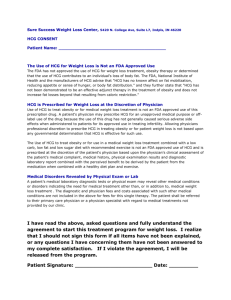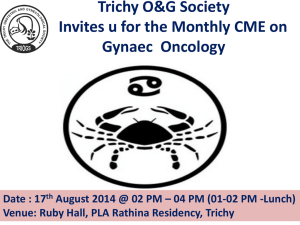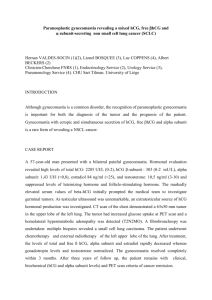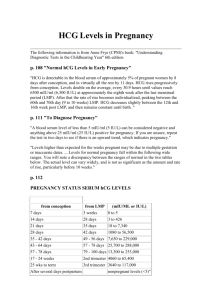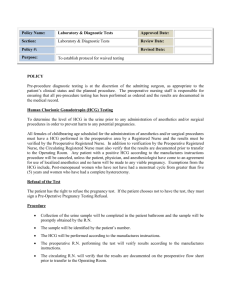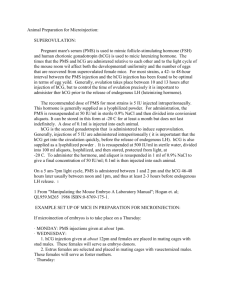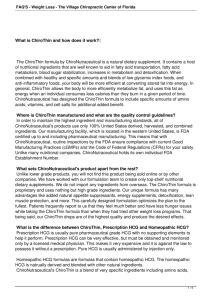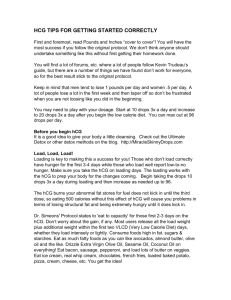UTILITY OF AN ORAL PRESENTATION OF hCG (human
advertisement
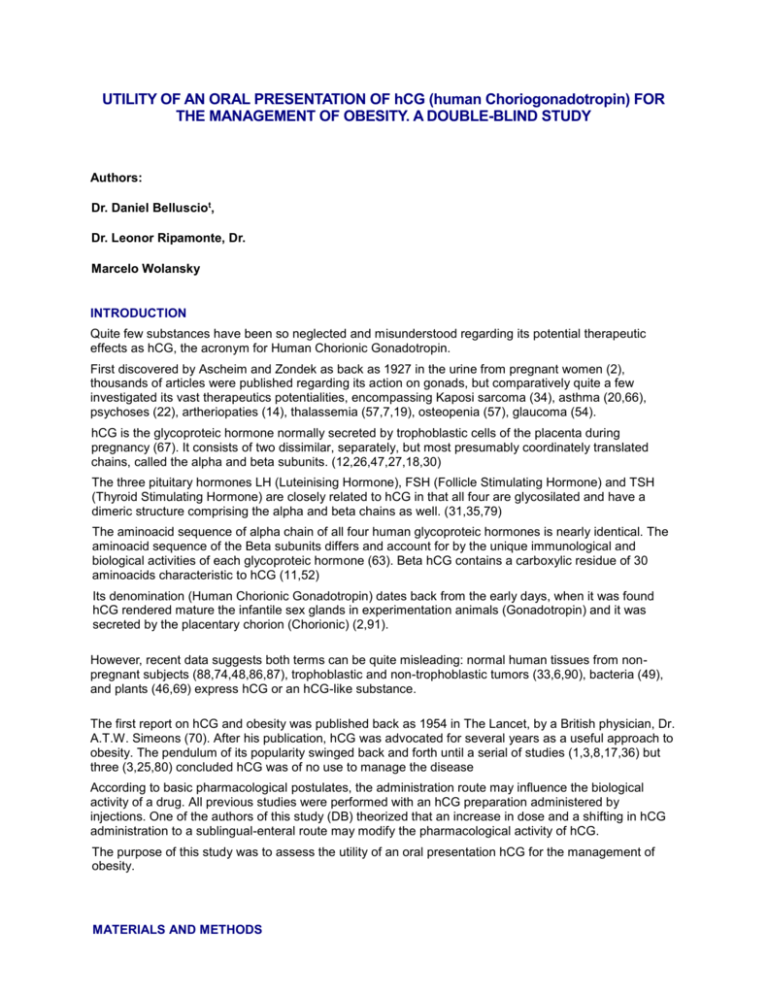
UTILITY OF AN ORAL PRESENTATION OF hCG (human Choriogonadotropin) FOR
THE MANAGEMENT OF OBESITY. A DOUBLE-BLIND STUDY
Authors:
Dr. Daniel Bellusciot,
Dr. Leonor Ripamonte, Dr.
Marcelo Wolansky
INTRODUCTION
Quite few substances have been so neglected and misunderstood regarding its potential therapeutic
effects as hCG, the acronym for Human Chorionic Gonadotropin.
First discovered by Ascheim and Zondek as back as 1927 in the urine from pregnant women (2),
thousands of articles were published regarding its action on gonads, but comparatively quite a few
investigated its vast therapeutics potentialities, encompassing Kaposi sarcoma (34), asthma (20,66),
psychoses (22), artheriopaties (14), thalassemia (57,7,19), osteopenia (57), glaucoma (54).
hCG is the glycoproteic hormone normally secreted by trophoblastic cells of the placenta during
pregnancy (67). It consists of two dissimilar, separately, but most presumably coordinately translated
chains, called the alpha and beta subunits. (12,26,47,27,18,30)
The three pituitary hormones LH (Luteinising Hormone), FSH (Follicle Stimulating Hormone) and TSH
(Thyroid Stimulating Hormone) are closely related to hCG in that all four are glycosilated and have a
dimeric structure comprising the alpha and beta chains as well. (31,35,79)
The aminoacid sequence of alpha chain of all four human glycoproteic hormones is nearly identical. The
aminoacid sequence of the Beta subunits differs and account for by the unique immunological and
biological activities of each glycoproteic hormone (63). Beta hCG contains a carboxylic residue of 30
aminoacids characteristic to hCG (11,52)
Its denomination (Human Chorionic Gonadotropin) dates back from the early days, when it was found
hCG rendered mature the infantile sex glands in experimentation animals (Gonadotropin) and it was
secreted by the placentary chorion (Chorionic) (2,91).
However, recent data suggests both terms can be quite misleading: normal human tissues from nonpregnant subjects (88,74,48,86,87), trophoblastic and non-trophoblastic tumors (33,6,90), bacteria (49),
and plants (46,69) express hCG or an hCG-like substance.
The first report on hCG and obesity was published back as 1954 in The Lancet, by a British physician, Dr.
A.T.W. Simeons (70). After his publication, hCG was advocated for several years as a useful approach to
obesity. The pendulum of its popularity swinged back and forth until a serial of studies (1,3,8,17,36) but
three (3,25,80) concluded hCG was of no use to manage the disease
According to basic pharmacological postulates, the administration route may influence the biological
activity of a drug. All previous studies were performed with an hCG preparation administered by
injections. One of the authors of this study (DB) theorized that an increase in dose and a shifting in hCG
administration to a sublingual-enteral route may modify the pharmacological activity of hCG.
The purpose of this study was to assess the utility of an oral presentation hCG for the management of
obesity.
MATERIALS AND METHODS
The study design was of the double-blind type: neither treating physician nor patient knowing who was
receiving hCG, or an inert substance (placebo). Female patients for the study were selected, since the
clinic where the study was performed specializes in the diagnosis and treatment of gynecologic
disorders. Details of the protocol were explained to eighty-three volunteers, who were solicited through a
written announcement. Before being entered into the study they signed an informed consent in front of a
neutral witness.
Inclusion criteria:
We required selected volunteers to meet the following criteria: being at least 25 % BMI (Body Mass
Index) overweight, and in general healthy condition. If taking medication for obesity, such as anorectics
or amphetamines, they should discontinue the medication at least one month prior the initiation of the
study. Drugs to control their clinical diseases (hypertension, hypothyroidism, etc.) were allowed. No
patients under steroid, diuretics or hormones were entered in the study. In the course of the study,
volunteers were also asked about starting the use of medical prescribed drugs or pharmaceutical
preparations during the trial period
Exclusion criteria:
No teenagers and patients over 75 y.o were admitted to the study. No patients with severe and/or
uncontrolled clinical diseases (cancer, IDDM, heart attacks, infarcts sequelae) were accepted. After
applying the inclusion/exclusion criteria, we counted upon seventy subjects to divide in treatment groups.
These women were assigned to groups Placebo (P, N=26) or hCG (N=44) by a simple randomized
sampling method. This latter group was in turn splitted in two subgroups: G1 (N=36) and G2 (N=8),
according to the hCG dose administered (see below).
All these patients were Caucasic, ages ranging from 23 to 73 y.o (group P: 41 ±13; group G1: 42 ± 12;
group G2: 41 ± 14), a range of heights of 1,62 cm. to 1,81 cm., and overweight ranging from 25 to 49,9
on BMI Tables.
Since there were no published reports on the oral use of hCG, except for one study posted by D.B. and
L.R. on the Internet (http://indexmedico.com/obesitv/hcg.htm ), group G2 was administered twice the
dose of G1, to assess if hCG concentration may affect obtained results.
The pharmacist prepared two types of vials: one containing saline solution (Na Cl 0,9% w/v) plus albumin
1 %, and the other containing a diluted solution (saline) of commercial, standardized hCG (from Gonacor,
Massone Pharmaceutical Industry). HCG Solution was prepared buffering the drug with Sodium
Bicarbonate and glycerin.
Vials were randomly labeled, each number corresponding to a patient. The pharmacist kept the codes in
a sealed envelope. They were opened after completing the protocol.
Volunteers from group G1 were administered a diluted solution of hCG (125 IU) b.i.d. (twice daily; total:
250 IU). One of the doses was taken before breakfast (fasting).
Volunteers from group G2 were given twice the amount of group G1: 250 IU b.i.d (a total of 500 IU
daily).
Diet plan: the same Very-Low-Calorie-Diet (VLCD), specific and detailed, was prescribed to all groups.
Breakfast: tea or coffee in any quantity without sugar. Only one tablespoonful of milk allowed in 24 hr.
Saccharin or other sweeteners could be used. Lunch: 100 grms. of veal, beef, chicken breast, fresh white
fish, lobster, crab or shrimp. All visible fat was carefully removed before cooking, and the meat weighed
raw. Salmon, tuna fish, herring, dried or pickled fish was not allowed. The chicken breast was removed
raw from the bird. One type of vegetable could be only chosen from the following: spinach, chard,
chicory, beet-greens, green salad, tomatoes, celery, fennel, onions, red radishes, cucumbers, asparagus,
and cabbage. One breadstick (grissini) or one Melba toast was allowed, and an apple or an orange, or a
handful of strawberries or one-half grapefruit.
For dinner: The same four choices as lunch.
The juice of only one lemon daily was allowed for all purposes. Salt, pepper, vinegar, mustard power,
garlic, sweet basil, parsley, thyme, marjoram, etc., could be used for seasoning, but no oil, butter or
dressing. Tea, coffee, plain water, mineral water were the only drinks allowed, but they could be taken in
any quantity and at all times.
Clinicometric controls:
Volunteers assisted twice weekly at the clinic to be controlled and weighed. The following evaluations
were completed once a week:
I.
Height and Weight, performed on a medical scale. Volunteers were weighed using normal
underwear
II.
Body circumferences. Using a flexible, non elastic metric tape, the following anatomic areas
were assessed:
• Wrist (WRT), at the level of flexion fold (wrist-forearm);
• Breast (BRE), submammary fold;
• Waist (WAT): at the hypogastric region level;
• Abdominal (ABD), at the navel level;
• Hips (HIP): pubic line;
• Thighs (THI): 8 cm. below pubic line;
• Suprapatelar (ROT), at the patella upper border;
• Ankle (ANK), at the flexion fold (peroneal protuberance).
III.
Skinfold thickness. Using a Lange Skinfold Caliper (Cambridge Scientific Industries,
Cambridge, Maryland), the following folds were examined:
• Tricipital (TRI), arm midline, posterior region and tricipital muscle zone.
• Anterior Axilar line (AXA), at the fold created when pinching the skin region at the level of
the pectoralis muscle extending to the arm;
• Subscapular (SCA <i)): inferior scapular spine;
• Thoracic (TOR): at the fold created when pinching the region located immediately below
the ribs, at the level of an imaginary line extending from anterior axilar line;
• Suprailiac (ILI), at the fold created 4 cm above the anterior superior iliac spine;
• Supraumbilical (UMB(U)), 3 cm above navel;
• Infraumbilical (UMB(i)), 3 cm below navel;
• Thighs (THI), internal aspect of thighs, eight cm below the pubic area;
• Patellar area (ROT), at the fold created when pinching the region located 6 cm medial to
the internal patellar border.
IV.
Bioelectrical impedance. Using Tetrapolar Bioelectrical Impedance (TBI) with a body fat
analyzer Maltron, model BF-905 (Maltron International Ltd., Rayleigh, Essex).
Volunteers were suggested to void, placed on supine position thereafter, and allowed to
rest half an hour before determination. Self-adhering electrodes were placed on
extremities. Every determination was performed with a separate set of electrodes that
were discarded after single use.
The following TBI determinations were assessed:
1. Fat weight (FW),
2. Lean weight (LW),
3. Water weight (WW),
4. Calories (CAL).
V.
VI.
β-hCG determinations: all subjects enrolled in the trial were studied for plasmatic phCG levels by an ELISA test (64) on 0-15-30 study days.
Mood questionnaire: from the first study week on, patients were given weekly selfadministered questionnaires to be completed at home. It consisted of twenty-four questions
related to their mood changes in the course of the study, plus four questions related to
adverse drug effects. They returned the data at the time of the subsequent visit to the clinic.
DATA ANALYSIS
Variables were splitted as follows for a better data processing and statistical results presentation:
• Category I, BW plus four bioelectrical impedance records (FW, LW, WW and CAL),
• Category II, eight anthropometrical measurements (corporal circumferences WRT,
BRE, WAT, ABD, HIP, THI, ROT and ANK).
• Category III, nine skinfold assessments (TRI, AXA, SCA {i), TOR, ILI, UMB(U), UMB(i),
THI, ROT) (see long names and definitions for the studied variables at the beginning of
this section).
Each set was analyzed with a two-way multivariate analysis of variance (MANOVA), comparing the
obtained Wilks-lambda' F with the corresponding critical value.
TREATMENT (VLCD diet plus group-specific pharmacological intervention) was considered the betweensubject factor with three levels (P, G1, G2), and WEEK of clinicometric control served as an additional
within-subject factor with six levels: weeks 0 to 5.
To estimate how the differences between treatment' groups depended on the trial time elapsed since
week zero (comparison of pattern trend changes in function of treatment time) we obtained the MANOVA
result for the effect of the INTERACTION (also presented in the text as TREATMENTx WEEK).
Moreover, to prevent any possible influence of acute effects specifically associated to any VLCD program
in the adaptation phase (first 5-7 days), we additionally evaluated with separate MANOVA analyses the
differences between groups and within subjects in the course of the last four treatment's weeks.
After obtaining a statistically significant multivariate test for a particular main effect or interaction, we
further examined the univariate F tests for each dependent variable. When parameters from these tests
displayed significant modifications, data were further analyzed to ascertain which group (P, G1 or G2)
was the responsible for the previous p values obtained. We also compared data basal values from each
group against those obtained in subsequent weeks (e.g., records of week 0 against week 1, thereafter
against week 2, and so on). These pain/vise comparisons were statistically assessed applying a post hoc
Scheffe F tests.
Questionnaire responses were converted into percentages and submitted to a chi-square (2%) test to
compare between-groups and within-groups (pairing off final vs. initial data) statistic results.
To attenuate the natural source of within-subject variation, inherent to all assessments of subjective
symptoms, we averaged data results from identical questionnaires completed weekly during the initial
first two study weeks. Thus, we obtained a more precise "initial questionnaire" (avoiding the potential
"adaptation effect" common to any VLCD regime in the first treatment week).
To obtain the final mood behavior results over the last two treatment weeks, they were averaged using
the same schema as detailed before. Criteria for significance was p<0.05. Statistica 4.2 (from StatSoft,
Inc.) for Windows software was used in all statistical processing.
RESULTS
All volunteers were submitted to the same VLCD schedule lasting five weeks. The objective of this work
was to gather data on the potential synergism between hCG administration and a VLCD plan. At the end
of the study we counted a total of 4.3 % missing data due to the absence of subjects in control days (no
one absent in more than two opportunities) as a consequence of personal situations not associated with
the experimental conditions. No statistic differences were obtained between Placebo and hCG groups
regarding missing data.
1. Regarding weight loss, similar results (with/without hCG administration) were obtained.
Bioelectrical impedance exhibited discrete modifications
As expected, for all types of clinicometric assessments, significant results were obtained through
MANOVA analysis on factor WEEK. Figures 1-2 (bioelectrical impedance and anthropometrical data,
respectively) show that the time-dependent changes were uniformly present in all tested groups. We
therefore estimated that the decreasing observed patterns were the consequence of VLCD acting upon
overweight patients. However, regarding skinfold thickness findings (Figures 3-4), we detected in P group
a noticeable tendency to attenuation of the within-subject variation during the last (third to fifth) study
weeks.
This data suggested us that this latter period might be the focus of our interest (see detailed analysis
below).Figure 1 shows the data patterns resulting in all groups from three representative variables (BW,
FW and LW) of the variable category I. The MANOVA analysis revealed nearly significant differences for
the INTERACTION (TREATMENT x WEEK) [F(50,58) =1.35 , p=0.13] in the absence of statistical
significance on analysis of TREATMENT as main effect [F(10,98)=1.22, p=0.29].
When all groups were submitted to multivariate and univariate analyses taking exclusively data from
weeks 2-5, we observed no significant difference result for the INTERACTION between group P and
hCG-treated groups. This finding could be related to differences in mean basal body weights and
treatment-dependent responses to the acute effects of VLCD during former weeks.
When post hoc Scheffe test was applied to compare the result from each weekly record (weeks 1-5) to its
corresponding basal value (week zero), we found similar patterns for all groups concerning analysis of
BW and TBI records (compare P vs. hCG-treated groups in every panel of Figure 1).
However, regarding the analysis of FW and BW data, we detected significant differences for the effect of
the INTERACTION (p<0.005 and p<0.05, respectively). Comparing FW patterns from groups P and G1: F
(5,230)=4.55, p<0.001. For the comparison P vs. G2, (BW and FW data), we obtained: F(5,140)=4.20
and 2.97, respectively (p<0.01 for both cases).
2. Ability of hCG to enhance diet-induced decreasing of waist and abdominal circumferences
Figure 2 shows the results for three (category II) body circumference assessments (WAT, ABD and HIP).
MANOVA analysis showed significant differences for factor TREATMENT as main effect [F (16,92)=1.92,
p<0.04], which we do not consider relevant due to the presence of higher basal records in group G2
when compared to the rest of the studied groups.
As a whole, the effect of the INTERACTION did not reveal statistical significance.
Nevertheless, significant differences were obtained after further analysis for the effect of the
INTERACTION upon variable WAT [F (10,265)=2.44, p<0.01, see panel A].
Data assessments from other circumferences did not show statistical differences for this effect between
groups [as representative examples, see ABD (p=0.35) and HIP records in panels B and C, respectively].
When the records of weeks 0-1 were subtracted from MANOVA analysis, almost all p values were slightly
affected. WAT and ABD measurements demonstrated to be still more affected by the INTERACTION: for
WAT, p<0.003; for ABD, p<0.08. The INTERACTION significance increased when P controls were
compared to subjects from group G2: comparing P vs. G2, and considering data from weeks 0-5, we
obtained: F (5,140)=2.87 (p<0.02) for WAT, and F(5,140)=1.80, (p=0.12) for ABD. But when we analyzed
data from weeks 2-5, we found the following: for WAT, F (3,84)=3.43 (p<0.02), for ABD, F (3,84)=2.73
(p<0.05).
3. Weak effects of hCG on a series of skinfold thickness reductions patterns
Figures 3-4 show results from subcutaneous fat evaluations, as assessed by skinfold thickness, on nine
selected skinfolds. Figure 3 presents three representative folds [TRI, SCA (i), ILI ( U)3 out of five (those
previous mentioned plus AXA and TOR) that demonstrated to be slightly affected by the pharmacological
treatment.
Analyzing skinfold data from weeks 0 to 5, the main effect TREATMENT showed statistical significance
(F(10,98)=2.39, p<0.02). However, prevailing higher basal records in group G2 might account for this
statistical significance. After studying the effect of the INTERACTION on skinfold results, statistics were
as follows: TRI (see panel A), p<0.08; AXA, p=0.98; SCA(i) (see panel B), p<0.005; ILI (see panel C),
p=0.23; TOR, p=0.35.
Performing pairwise comparisons between control P and hCG-treated groups, we observed that the
higher significances obtained for SCA (i) and TRI skinfolds derived mainly from the comparison between
P and G2: for TRI, F (5,140)=2.55, p<0.04, for skinfold SCA(i), F (5,140)=6.02, p<0.0001. MANOVA
analysis run on weeks 2-5 data resulted in a significance increase for TREATMENT as main effect [F
(10,98)=2.55, p<0.009]. In addition, the INTERACTION was enhanced on data from SCA(i) assessment
(p<0.00005): by comparing data from groups P and G2 during weeks 2 to 5: for TRI, F (3,84)=2.08
(p<0.04), for SCA(i), F (3,84)=9.31.
4. Higher response rates in a different skinfold series by treatment with hCG plus a VLCD
In Figure 4 we display skinfold thickness results obtained from another series of four examined skinfolds
[UMB (U), UMB ^ THI, ROT(U)]. MANOVA analysis resulted in a nearly significant INTERACTION [F
(40,68)=1.55, p<0.06] in the absence of statistical significance for TREATMENT as main effect
[F(8,100)=1.43, p=0.20].
When the specific effect of the INTERACTION was evaluated for each skinfold, highly significant
differences were found. By computing F (10,265) values, we obtained the following results: UMB ( U) (see
panel A), p<10-3; UMB (() (see panel B), p<10-5; ROT (see panel C), p<0.05; THI (see panel D), p<10-6.
When we restricted the data analysis from weeks 2 to 5, we found nearly significant results for factor
TREATMENT as main effect [F (8,100)=1.75, p<0.1] and for the effect of the INTERACTION [F
(24,84)=1.55, p<0.06]. The INTERACTION was further studied pairing P group against each hCG-treated
group in separate multivariate analyses.
By comparing P vs. G1, we found: for UMB(i), p<0.04, and for RQT , p<0.03 (UMB (U) and THI achieved
nearly significant p values). Again, the strength of the INTERACTION [TREATMENT x WEEK] was higher
when group G2 was selected for the comparison.
From the obtained data, it becomes clear that skinfolds determinations in Q2 subjects showed a
differential response to VLCD schedule with respect to that of P controls (for INTERACTION, in these
points of skinfold assessment, p<0.0005).
5. The selective response of some skinfolds to hCG was suggestive to be dependent
on dose
The experimental design of this investigation was not intended to determine the dose-response curve for
hCG acting on diet-induced effects.
However, the effects of hCG on some of these skinfolds seemed to be dependent on dose, since it was
found significant differences for the effect of the INTERACTION after the comparison between G1 vs. G2
groups for UMB(U) (p<0.001) and UMB(i)(p<0.005), and a nearly significant p value for THI (p=0.11).
Figure 4 also displays the percentages of skinfold thickness reduction from the beginning to the end of
the clinical trial. We found skinfolds decreases for group G1 ranging from over 22% (for UMB (U>, see
panel A) up to over 115% (for THI, see panel D) over respective decreases in P group. These differences
were still higher when G2-subjects were compared to P controls: by computing the ratio between
decrease percentages, G2 had over twice (for UMB(U), see panel A) to over four-fold (for THI, see panel
D) the skinfold records drops observed in group P (see each actual percentage, group by group, in Fig.
4).
Most of the differences between hCG-treated subjects and P controls regarding skinfold reduction
rates were enhanced when data corresponding to week five was compared to records of week two
instead week zero (data not shown).
6. Improvement of mood-related parameters by the effect of hCG treatment
In Figure 5 we display the responses to four representative questions asking about the occurrence
frequency for specific mood-related events, according to a multiple choice designed questionnaire
completed every treatment week by all the subjects enrolled in the trial.
Panels A to D display the initial and final questionnaire results, expressed as percentages for each
optional response (covering a four-option frequency scale from never to frequent).
Using this procedure, we expected to find in tested volunteers skewness towards either sense concerning
their behaviors and feelings in response to a diet and a pharmacological intervention.
For all these questions, and compared to control subjects, hCG-treated volunteers (G1+G2) showed a
trend to improvement of inter-personal contacts and mood control when confronting upsetting or
conflicting situations.
Pairing off final (f) vs. initial (i) distribution of percentages for optional responses, we particularly found
statistical significance in two of these questions in group G (after \ test: 2X3=16.3, p<0.002, and 2X3=7.82,
p<0.05; see right sectors of panel A and B, respectively).
P group-subjects did not present temporal differences (see panel A), or were adversely affected in their
mood during the trial 2X3=14.4, p<0.002 (compare in panel B corresponding initial and final values for
group P and G).
Furthermore, group P exhibited in other two questions certain skewness to the impairment of its mood
(see left half of panels C and D, p<10-5 ); for group G we obtained the 2X3 values 1.51 and 3.98,
respectively (p>0.3), indicating the absence of temporal mood changes.
For all other mood-related questions, no statistical significant difference between groups was found (data
not shown).
We also included some questions intended to evaluate the potential occurrence of treatment-dependent
clinical anomalies regarding hormonal, physiological or metabolic disorders. We found no significant
difference after final vs. initial records' comparison (data not shown).
7. No detectable β-hCG plasmatic levels in all tested groups.
On treatment days 0, 15 and 30 we have tested all volunteers, screening for the presence of plasmatic phCG. Concentrations were undetectable in all cases (data not shown).
DISCUSSION
Concerning hCG and its utility for the management of obesity, this study introduces two new aspects, and
adds new data for a third:
I) This is the first report assessing variables not included in previous reports (, 38,51,68,89);
II) We report a new administration route for hCG management of obesity, the oral approach, which
has never been reported before;
III) We have detected mood changes in hCG treated patients, regarding a better confrontation of
daily emotionally conflicting situations.
These assertions will be separately discussed:
I) Skinfold thickness (SKF) and Tetrapolar Bioelectric Impedance (TBI) records.
Both approaches have been extensively discussed in the literature. It was shown that the
correlation between the values obtained with the two methods to be linear and highly significant for
both sexes (42,81,27).
There is general agreement that skinfolds calipers are particularly useful in the clinical setting
(56,82,16,76,10,65, 9,15,75), particularly in view of the fact that measurement of subcutaneous
body fat at different body sites is becoming increasingly important for the characterization of risk of
certain disease states (55).
When comparing skinfolds assessments to body circumference estimates, despite some data
suggests that the latter approach appears to be more sensitive in the determination of
subcutaneous body fat (53), this procedure is in our opinion subjected to clinical variables (bloating
syndrome after a meal, premenstrual water retention, etc.) that may affect negatively on the final
estimates results. Also, when comparing SKF to body contour assessments, some data suggests
that the pattern of fat thickness body distribution measured over a number of specific sites by one
method of measurement is unlikely to be duplicated by of the other method on the same individual
(40,41).
Adipose tissue patterns show great variability, indicating the importance of using skinfold caliper
readings from a variety of different anatomic sites including upper limbs, lower limbs and trunk
(30,65).
According to the above conclusions from several authors (72,13,60, 25,73,62), we would like to suggest
that former studies on hCG and obesity lacked of sufficient data to accurately estimate modifications of
adipose tissue distribution in tested volunteers. Consequently we designed the study to assess as many
as possible variables.
As far as our study concerns, we subjected each volunteer enrolled in the trial to four bioelectrical
impedance, eight anthropometrical plus nine SKF evaluations. Performing this multiple site
determinations, our results indicate that specific SKF are highly responsive to hCG pharmacological
intervention (upper and lower umbilical). The greater response was obtained in those regions where the
corresponding circumference assessments resulted in nearly significant or significant decreases through
the trial period (see waist and abdomen records in Fig. 2 and the above detailed description of statistical
results for the effect of the interaction).
II) Oral hCG might be an alternative therapeutic administration route.
No data appears on the scientific literature regarding an oral administration of hCG in humans.
But results from this study suggest hCG may be used by the sublingual-enteral route. Despite
plasmatic B-hCG remained undetectable both in Placebo and hCG groups throughout the study,
an oral administration of hCG proved to possess therapeutic activity.
Since commercial preparations of hCG contains B-endorphin (see below), it may be tempting to
hypothesize that this pentapeptide might account for the pharmacological activity observed on
mood stability in the course of the Protocol.
III) Volunteers treated with hCG coped better with daily irritating situations.
As can be seen on Figure 5, hCG-treated groups handled better their irritability, their mood at
home, and were less prone to episodes of extreme nervousness capable of provoking violent
discussions . Several reports proposed hCG might be used for the treatment of psychoses or
neurosis (29,61,24). Our study appears to corroborate these proposals.
To conclude, this study poses several still unanswered questions:
1. hCG absorption. We have tested all volunteers, screening for the p-hCG in plasma. Concentrations
were undetectable in all cases.
Therefore, which hCG fraction is responsible for the pharmacological activity observed in our study?.
hCG molecular size (alpha chain -14,500 KD; beta chain -22,200 KD) makes highly improbable that the
entire molecule has been absorbed. Our hypothesis is that only a fraction of the entire hCG molecule is
absorbed through this administration route .
2. hCG and lipid metabolism. We do not know precisely how hCG acts on adipose tissue metabolism.
However, some reports (32,84,85,83 ) suggest hCG possesses a metabolic activity on adipose tissue
(i.e. decrease lipogenesis). These actions are not directly exerted upon adipocytes, since fat cell
membranes have no receptors for hCG (32).
3. hCG and mood. A stable mood and lack of attrition characterized the hCG-treated group.
It is well known that VLCD's are associated with mood changes, particularly attrition (78)
during the dieting period. In one study, disinhibition and hunger were significantly related
to anxiety and depression while restraint was not (44). Another study concluded that
elevated levels of anxiety persist in female patients throughout a VLCD course of
treatment (45).
Also, many patients complain about fatigue in the course of a VLCD (4)
Conversely, our data suggests that hCG-treated volunteers rather improved their attitude towards their
environment, in the sense of an enhanced well-being, less irritability and lack of fatigue. Since
commercial preparations of hCG contains β-endorphin (39) and this neuropeptide has been
demonstrated to affect the function of limbic-emotional circuits (21,58,5,28), we hypothesized that the pendorphin fraction present in commercial preparations of hCG might account for the activity observed
regarding mood control.
Additional studies remain to be performed to test the validity of this hypothesis.
CONCLUSIONS
1. Female obese volunteers participating in a double blind study, and submitted to the administration of
an oral presentation of hCG plus a VLCD, decreased specific body circumferences and skinfold
thickness from conspicuous body areas more efficiently than Placebo+VLCD -treated subjects.
Since a significant fat proportion from total body fat is subcutaneously located (50 to 65 percent,
depending on sex and fat distribution), this hCG metabolic activity would result in a reduction of the
total body fat mass, the main cause for obesity. We suggested that the combination of a VLCD and
oral hCG could not only trigger clinically significant changes in subcutaneous fat stores but
simultaneously decrease body weight and modelate body contour.
2. hCG oral administration proved to be a safe and effective procedure on obese treated volunteers.
No side effects were observed in the course of the study. There are no reports in the literature
regarding this administration route to compare our findings.
3. Compared to placebo treated subjects, volunteers managed with an oral
administration of hCG coped more efficiently with daily irritating situations, were in a better mood,
and handled home conflicts without stepping up family discussions.
This study appears to contradict former conclusions on the issue of hCG and obesity. We attribute those
differences to a different approach, including variables not assessed in former publications.
Acknowledgements:
One of the authors of the report (Dr. Belluscio, Daniel) was granted with a staying period at the Bellevue
Klinik, Zurich, Switzerland, to be trained on the clinical management of the hCG method. He would like to
thanks Dr. Trudy Vogt (Clinic Director) for her generous contribution through this grant to part of the
ongoing Research Program performed at her Institution.
FIGURES
Figure 1. Body weight and bioelectrical impedance records.
During five weeks of hypocaloric diet the subjects enrolled in the clinical trial were simultaneously
administered a daily dose of 250 Ul hCG (group G1, N=36), or 500 Ul (group G2, N=8). A third group
(Placebo) received an equivalent volume of saline solution (group P, N=26). Data was obtained at the
beginning and weekly during the trial period (records 0 to 5) for Body Weight (panel A) and four
bioelectrical impedance assessments (here it is only displayed details from Fat and Lean weights on
panels B and C, respectively).
Data are expressed in kg, mean ± SD (bars at top). Results were submitted a priori to MANOVA analysis.
When multivariate and univariate analyses were performed taking exclusively data from weeks 2 to 5,
differences between groups were strongly attenuated (see details in the text). The asterisks mark
statistically significant differences between weekly records (weeks 1 to 5), and the corresponding basal
values determined in week 0 (analyzed a posteriori by Scheffe F test). p<0.05, ** p<0.0002, ***
p<0.0005
Figure 2. Body circumferences.
Here we display the basal ("0") and subsequent five weekly results (weeks 1 to 5) from three out of eight
anthropometrical parameters examined in this work. Panel A=Waist. Panel B=Abdomen. Panel C=Hip.
All results are expressed in cm, mean ± SD (bars at top). Regarding all corporal circumferences
assessed, only Waist and Abdomen were significantly affected by the interaction of TREATMENT [diet
plus pharmacological treatment] and WEEK (trial stage). These differences appeared enhanced when
only data from weeks 2 to 5 was gathered to perform a separate MANOVA analysis (other details in
legend of Figure 1) p<0.05
**p<0.0005
***p<10-6 #p<0.005
Figure 3: Skinfold thickness reduction on five "low-responsive" skinfolds.
Simultaneously with bioelectrical impedance and anthropometrical assessments, we examined
subcutaneous fat stores by plicometries. Results are expressed in mm, means ± SD (at top). Only
Tricipital (see panel A) and Sub-scapular (see panel B) skinfold assessments demonstrated significant o
nearly significant differences by comparing group G2 and the control P for the effect of TREATMENT or
the INTERACTION (see statistical analysis details in the text).
It is also shown the data obtained for Suprailiac (see panel C) skinfold. Concerning these series of low
responsive skinfolds, no relevant difference between groups was raised after pairwise comparisons of
each treatment weeks' record with its corresponding basal value: by Scheffe test, * p<0.03, ** p<0.0005
Figure 4: Plicometries on four "high-responsive" skinfolds.
Here it is shown a different series of skinfolds displaying a clear treatment-dependent behavior, most
noticeable from the second week of treatment on. When last four treatment' weeks were submitted to
study, MANOVA analysis resulted in nearly significant differences for factor TREATMENT and the
INTERACTION.For each of these skinfolds, highly significant statistical results were found between G2
and P groups for the effect of the INTERACTION.
In this Figure we can observe the percentages of skinfold thickness reductions, comparing data obtained
at the end of the trial with the corresponding basal values (week zero). P values resulting from Scheffe
test are marked by asterisks as follows: * p<0.05, ** p<0.0005, *** p<10"4, # p<0.01, ## p<10'6. See other
details in the legend of Fig. 3 and the text.
Figure 5: Mood assessment.
The figure presents the responses to four representative questions from a total of twenty-eight asked to
volunteers at the end of every treatment' week by means of an auto administered questionnaire.
Questions included were related to aspects of inter-personal relations, well-being, mood self control when
confronting conflictive situations, etc. (see titles of panels A to D).
All data from subjects pertaining to groups G1 and G2 were pooled ("group G") for data analysis. Initial
and final results are shown with letters / and f, respectively .In the abscissa axis: Pi (Placebo: initial), Pf
(Placebo: final); Gi (hCG: initial) and Gf(hCG: final) respectively. Statistical significant differences within
groups between final and initial questionnaires responses were obtained by applying 2x test as follows:
for group G, * p<0.05 (panel A) and ** p<0.002 (panel B); for group P, ** p<0.002 (panel B) and *** p<10' 5
(panels C and D)
References / Referencias
1. Albrink MJ. Chorionic gonadotropin and obesity?. Am J Clin Nutr 1969 Jun;22(6):6815
2. ASCHEIM S; ZONDEK B. Die Shwangerschafts Diagnose aus dem Harn durch
nachweis der Hypophysovorderlappenhormone. Klin. Wochschr. 7:1401-1411. 1928
3. Asher WL. Harper HW. Effect of human chorionic gonadotrophin on weight loss.
hunger. and feeling of well-being. Am J Clin Nutr 1973 Feb;26(2):211-8
4. Astrup A.. VLCD compliance and lean body mass. Int J Obes 1989;13 Suppl 2:27-31
5. Atkinson JH. et al.. Plasma measures of beta-endorphin/beta-lipotropin-like
immunoreactivity in chronic pain syndrome and psychiatric subjects. Psychiatry Res.
1983 Aug;9(4):319-27
6. Bagshawe KD. et al.. Pregnancy beta1 glycoprotein and chorionic gonadotrophin in
the serum of patients with trophoblastic and non-trophoblastic tumors. Eur J Cancer.
1978 Dec;14(12):1331-5
7. Balducci R. et al.. Effect of hCG or hCG+ treatments in young thalassemic patients
with hypogonadotropic hypogonadism. J Endocrinol Invest. 1990 Jan;13(1):1-7
8. Ballin JC. White PL. Fallacy and hazard. Human chorionic gonadotropin-500-calorie
diet and weight reduction. JAMA 1974 Nov 4;230(5):693-4
9. Bastow MD. Anthropometrics revisited. Proc Nutr Soc 1982 Sep;41(3):381-8
10. Berry JN. Use of skinfold thickness for estimation of body fat. Indian J Med Res
1974 Feb;62(2):233-9
11. Birken S. et al.. Isolation and amino acid sequence of COOH-terminal fragments
from the beta subunit of human choriogonadotropin. J Biol Chem. 1977 Aug
10;252(15):5386-92
12. Birken S.. Chemistry of human choriogonadotropin. Ann Endocrinol (Paris).
1984;45(4-5):297-305
13. Birmingham CL. et al.. Human chorionic gonadotropin is of no value in the
management of obesity. Can Med Assoc J. 1983 May 15;128(10):1156-7
14. Bonandrini L. et al.. Chorionic gonadotropin (HCG) in the therapy of chronic
peripheral obliterating arteriopathy (CPOA) of the lower extremities caused by
arteriosclerosis. Minerva Chir. 1970 Mar 15;25(5):368-83
15. Borkan GA et al.. Comparison of ultrasound and skinfold measurements in
assessment of subcutaneous and total fatness. Am J Phys Anthropol 1982
Jul;58(3):307-13
16. Borkan GA, Hults DE, Gerzof SG, Burrows BA, Robbins AH.Relationships between
computed tomography tissue areas, thicknesses and total body composition.
Ann Hum Biol. 1983 Nov-Dec;10(6):537-45.
17. Bosch B. et al.. Human chorionic gonadotrophin and weight loss. A double-blind.
placebo-controlled trial. S Afr Med J 1990 Feb 17;77(4):185-9
18. Bousfield GR. et al.. Structural features of mammalian gonadotropins. Mol Cell
Endocrinol. 1996 Dec 20;125(1-2):3-19
19. Bozzola M. et al.. Effect of human chorionic gonadotropin on growth velocity and
biological growth parameters in adolescents with thalassemia major. Eur J Pediatr. 1989
Jan;148(4):300-3
20. Bradley P. Human chorionic gonadotrophin [letter]. Med J Aust Sep 25;2(13):510-1
1976
21. Brambilla F. et al.. beta-Endorphin and beta-lipotropin plasma levels in chronic
schizophrenia. primary affective disorders and secondary affective disorders.
Psychoneuroendocrinology. 1981 Dec;6(4):321-30
22. Bujanow W. Hormones in the treatment of psychoses. Br Med J Nov 4;4(835):298
1972
23. Bujanow W.Letter: Is oxytocin an anti-schizophrenic hormone?
Can Psychiatr Assoc J. 1974 Jun;19(3):323. No abstract available.
24. Cairella M.. Drug therapy of obesity. Clin Ter. 1978 Mar 31;84(6):571-92
25. Canfield RE. et al.. Studies of human chorionic gonadotropin. Recent Prog Horm
Res. 1971;27:121-64
26. Cole LA.. Immunoassay of human chorionic gonadotropin. Its free subunit and
metabolites. Clin Chem. 1997 Dec;43(12):2233-43
27. Emrich HM. Endorphins in psychiatry. Psychiatr Dev 1984 Summer;2(2):97-114
28. Ferrari C.. Use of a testosterone-gonadotropin combination in the treatment of
pathological syndromes in adult males. Minerva Med. 1972 Jun 2;63(42):2399-408
29. Fiddes JC. et al.. Structure. expression. and evolution of the genes for the human
glycoprotein hormones. Recent Prog Horm Res. 1984;40:43-78
30. Fiddes JC. et al.. The gene encoding the common alpha subunit of the four human
glycoprotein hormones. J Mol Appl Genet. 1981;1(1):3-18
31. Fleigelman R. Metabolic effects of human chorionic gonadotropin (HCG) in rats.
Proc Soc Exp Biol Med 1970 Nov;135(2):317-9
32. Gailani S. et al.. Human chorionic gonadotrophins (hCG) in non-trophoblastic
neoplasms. Assessment of abnormalities of hCG and CEA in bronchogenic and
digestive neoplasms. Cancer. 1976 Oct;38(4):1684-6
33. Gallo RC. Bryant J. Antitumor effects of hCG in KS. Nat Biotechnol Mar;16(3):218
1998
34. Giudice LC. et al.. Glycoprotein hormones: some aspects of studies of secondary
and tertiary structure. Monograph. 1979 May 23
35. Greenway FL. et al.. Human chorionic gonadotropin (HCG) in the treatment of
obesity: a critical assessment of the Simeons method. West J Med 1977
Dec;127(6):461-3
36. Grzonkowski S. Analysis of the results of the measurements of adipose tissue in the
human body based on the study of skinfold thickness. Przegl Epidemiol 1989;43(3):27282
37. Gusman HA. Chorionic gonadotropin in obesity. Further clinical observations. Am J
Clin Nutr 1969 Jun;22(6):686-95
38. Hashimoto TK. Chorionic gonadotropin preparation as an analgesic. Arch Intern
Med 1981 Feb;141(2):269
39. Hayes PA. Sub-cutaneous fat thickness measured by magnetic resonance imaging,
ultrasound , and calipers. Med Sci Sports Exerc 1988 Jun;20(3):303-9
40. Weiss LW, Clark FC.Three protocols for measuring subcutaneous fat thickness on
the upper extremities.Eur J Appl Physiol. 1987;56(2):217-21.
PMID: 3552659; UI: 87190331
41. Heitmann BL et al. Evaluation of body fat estimated from body mass index, skinfolds
and impedance. A comparative study. Eur J Clin Nutr 1990 Nov;44(11):831-7
42. Hermans P. Clumeck N. Picard O. et. Al.. AIDS-related Kaposi's sarcoma patients
with visceral manifestations. Response to human chorionic gonadotropin preparations. J
Hum Virol Jan-Feb;1(2):82-9. 1998
43. LaPorte DJ. Predicting attrition and adherence to a very low calorie diet: a
prospective investigation of the eating inventory. Int J Obes 1990 Mar;14(3):197-206
44. LaPorte DJ. Treatment response in obese binge eaters: preliminary results using a
very low calorie diet (VLCD) and behavior therapy. Addict Behav 1992;17(3):247-57
45. Leshem Y. et al.. Gonadotropin promotion of adventitious root production on cuttings
of Begonia semperflorens and Vitis vinifera. Plant Physiol. 1968 Mar;43(3):313-7
46. Lustbader JW. et al.. Structural and molecular studies of human chorionic
gonadotropin and its receptor. Recent Prog Horm Res. 1998;53:395-424
47. Malkin A. The presence of glycosilated, biologically active chorionic gonadotropin in
human liver. Clin Biochem 1985 Apr;18(2):75-7
48. Maruo T. et al.. Production of Choriogonadotropin-like factor by a microorganism.
Proc Natl Acad Sci U S A. 1979 Dec;76(12):6622-6
49. McGarvey ME. Tulpule A. et. Al.. Emerging treatments for epidemic (AIDS-related)
Kaposi's sarcoma. Curr Opin Oncol Sep;10(5):413-21 1998
50. Miller R. et al.. A clinical study of the use of human chorionic gonadotrophin in
weight reduction. J Fam Pract. 1977 Mar;4(3):445-8
51. Morgan FJ. et al.. Chemistry of human chorionic gonadotropin. Monograph. 1976
May 25
52. Mueller WH. Relative reliability of circumferences and skinfolds as measures of
body fat distribution. Am J Phys Anthropol 1987 Apr;72(4):437-9
53. Niebroj TK. et al.. Effect of chorionic gonadotropins administration on water
metabolism in glaucomatous women. Endokrynol Pol. 1971 May-Jun;22(3):251-5
54. Orphanidou C. Accuracy of subcutaneous fat measurement: comparison of skinfold
calipers. ultrasound, and computed tomography. J Am Diet Assoc 1994 Aug;94(8):855-8
55. Orphanidou CI, McCargar LJ, Birmingham CL, Belzberg AS.Changes in body
composition and fat distribution after short-term weight gain in patients with anorexia
nervosa.Am J Clin Nutr. 1997 Apr ; 65 (4) :1034-41.
56. Perniola R. et al.. Human chorionic gonadotrophin therapy in hypogonadal
thalassaemic patients with osteopenia: increase in bone mineral density. J Pediatr
Endocrinol Metab. 1998;11 Suppl 3:995-6
57. Pickar D et al.. Clinical studies of the endogenous opioid system. Biol Psychiatry
1982 Nov;17(11):1243-76
58. Pierce JG.. Eli Lilly lecture. The subunits of pituitary thyrotropin--their relationship to
other glycoproteic hormones. Endocrinology. 1971 Dec;89(6):1331-44
59. Rabe T. et al.. Risk-benefit analysis of a hCG-500 kcal reducing diet (cura romana)
in females. Geburtshilfe Frauenheilkd. 1987 May;47(5):297-307
60. Reiss M.. Stunted growth and the mechanism of its stimulation in mentally disturbed
adolescents. Int J Neuropsychiatry. 1965 Aug;1(4):313-7
61. Rivlin RS.. Therapy of obesity with hormones. N Engl J Med. 1975 Jan 2;292(1):269
62. Ross GT.. Clinical relevance of research on the structure of human chorionic
gonadotropin. Am J Obstet Gynecol. 1977 Dec 1;129(7):795-808
63.Sanders S, Norman AP.Chorionic gonadotrophin in male growth-retarded adolescent
asthmatic patients.Practitioner. 1973 May;210(259):690-2.
64. Sarma JM. Houghten RA. Enzyme linked immunosorbent assay (ELISA) for betaendorphin and its antibodies. Life Sci 1983;33 Suppl 1:129-32
65. Sarria A et al.. Skinfold thickness measurements are better predictors of body fat
percentage than body mass index in male Spanish children and adolescents. Eur J Clin
Nutr 1998 Aug;52(8):573-6
66. Scaffidi A. Data on the pathogenesis and therapy of bronchial asthma in patients
with secondary hypogonadism. Minerva Med Dec 1;65(86):4473-6 1974
67. Segal SJ (ed.). Chorionic Gonadotropin. Plenum Press: NY. 1980
68. Shetty KR. et al.. Human chorionic gonadotropin (HCG) treatment of obesity. Arch
Intern Med. 1977 Feb;137(2):151-5
69. Shomer-Ilan A. et al.. Further evidence for the presence of an endogenous
gonadotrophin-like plant factor: "phytotrophin" .Isolation and mechanism of action of the
active principle. Aust J Biol Sci. 1973 Feb;26(1):105-12
70. Simeons ATW. The action of chorionic gonadotropin in the obese. Lancet II:1954:
946-947
71. Simeons ATW.. Pounds and Inches: A new approach to obesity. Private Printing
(1976)
72. Stein MR. et al.. Ineffectiveness of human chorionic gonadotropin in weight
reduction: a double-blind study. Am J Clin Nutr. 1976 Sep;29(9):940-8
73. Stern JS.. Weight control programs. Curr Concepts Nutr. 1977;5:137-55
74. Suginami H. et al.. Immunohistochemical localization of a human chorionic
gonadotropin-like substance in the human pituitary gland. J Clin Endocrinol Metab. 1982
Dec;55(6):1161-6
75. Tagliabue A et al.. Application of bioelectric impedance measurement in the
evaluation of body fat. Recenti Prog Med 1989 Feb;80(2):59-62
76. Talbot LA et al.. Assessing body composition: the skinfold method. AAOHN J 1995
Dec;43(12):605-13
77. Tavio M. Nasti G. Simonelli C. et. Al.. Human chorionic gonadotropin in the treatment
of HIV-related Kaposi's sarcoma. Eur J Cancer Sep;34(10):1634-7 1998
78. Torgerson JS et al.. VLCD plus dietary and behavioral support versus support alone
in the treatment of severe obesity. A randomised two-year clinical trial. Int J Obes Relat
Metab Disord 1997 Nov;21(11):987-94
79. Vaitukaitis JL.. Glycoprotein hormones and their subunits--immunological and
biological characterization. Monograph. 1979 May 23
80. Veilleux H. et al.. Gonadic and extragonadic effects in humans of 3.500 I.U. of HCG
(human chorionic gonadotropin) in fractional doses. Vie Med Can Fr. 1972
Sep;1(9):862-71
80b.Vogt T, Belluscio D.Controversies in plastic surgery: suction-assisted lipectomy
(SAL) and the hCG (human chorionic gonadotropin) protocol for obesity treatment.
Aesthetic Plast Surg. 1987;11(3):131-56. Review.
81. Wattanapenpaiboon N. et al.. Agreement of skinfold measurement and bioelectrical
impedance analysis (BIA) methods with dual energy X-ray absorptiometry (DEXA) in
estimating total body fat in Anglo-Celtic Australians. Int J Obes Relat Metab Disord.
1998 Sep;22(9):854-60
82. Weits T. et al.. Comparison of ultrasound and skinfold caliper measurement of
subcutaneous fat tissue. Int J Obes 1986;10(3):161-8
83. Yanagihara Y. Carbohydrate and lipid metabolism in pregnant albino rats during
hunger after loading with gonad-stimulating hormones. Nippon Sanka Fujinka Gakkai
Zasshi 1966 Nov;18(11):1293-301
84. Yanagihara Y. Carbohydrate and fatty acid metabolism in pregnant albino rats
simultaneously loaded with fat emulsion and sex stimulating hormones during
starvation. Nippon Sanka Fujinka Gakkai Zasshi 1967 Jan;19(1):8-14
85. Yanagihara Y. Carbohydrate and lipid metabolism in pregnant albino rats during
starvation after loading with gonad-stimulating hormones. Nippon Sanka Fujinka Gakkai
Zasshi 1966 Dec;18(12):1379-84
86. Yoshimoto Y. et al.. Human chorionic gonadotropin--like material: presence in
normal human tissues. Am J Obstet Gynecol. 1979 Aug 1;134(7):729-33
87. Yoshimoto Y. et al.. Human chorionic gonadotropin-like substance in nonendocrine
tissues of normal subjects. Science. 1977 Aug 5;197(4303):575-7
88. Young RL. et al.. Chorionic gonadotropin in weight control. A double-blind crossover
study. JAMA. 1976 Nov 29;236(22):2495-7
89. Zakut H. et al.. hCG as tumor marker in non-trophoblastic neoplasms. Harefuah.
1985 Jan 15;108(2):82-5
90. Zondek B. Sulman F. The mechanism of action and metabolism of gonadotrophic
hormones in the organism. Vit Horm 1945 3:297-336
